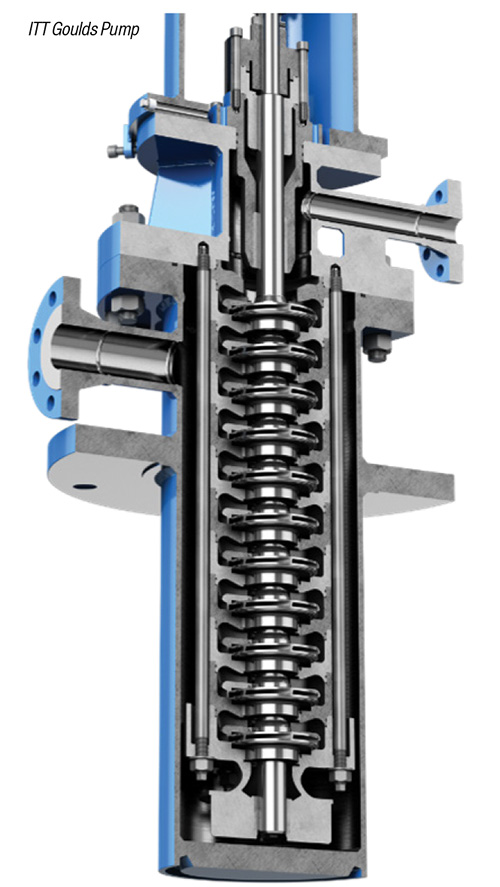Finding the correct pump for an oil-and-gas plant application improved reliability and eliminated priming issues
A leading oil-and-gas midstream service provider in the U.S. was experiencing ongoing maintenance and costly repairs for the integrally geared pump it was using for a critical service. The pump in service posed consistent issues with priming, and utilized a gearbox-driven single-stage rotor that ran at a rate of 8,693 rpm — a much higher speed than traditional two- or four-pole motors.
The high rotor speed forced the mechanical seal to operate at the higher speeds of the impeller, drastically increasing the wear and tear to the pump and causing machine failure. With consistent disruption and the need for repair, the total cost of ownership for the customer was rapidly climbing.
Pump replacement
To reduce downtime and other challenges associated with the pump, the midstream service provider decided to make a change. The company purchased a Goulds Pumps VICR (Vertically Industrial Can Radial) Type VS6 pump for its fractionation knock-out (KO) drum pump in one of its ethane plants.
The new 10RMC-11 stage pump (Figure 1) runs at 3,600 rpm. This lower rotor speed significantly extended the operating life of the new pump over the old one, and drastically decreased maintenance needs. In fact, since the VICR was installed in 2020, the pump has not required any repairs, nor has it required any seal changes. The pump’s estimated service interval is about five years, which is significantly longer than some other pumps that have an estimated service life as low as six months.

FIGURE 1. The radial impellers and diffusers of the VICR are held together by tie rods. This compact design results in a much shorter hydraulic unit compared to a typical vertical turbine style of VS6
The barrel-style pump also eliminates any priming issues and can be designed to increase the available net positive suction head (NPSHa) by lengthening the barrel. The user has been so pleased with the VICR’s operation and reliability that in 2021, the company purchased a spare pump — although it has not yet been needed.
The VICR pump has vertical hydraulics, which allow for higher staging without the concern for the shaft sagging and dragging in the center, as is a common issue for horizontally configured equipment.
The new pump
When a mechanical seal does need to be changed, the VICR enables it to be replaced with the installed pump and motor due to a spacer coupling above the seal, allowing for easy removal and replacement. This means the seal can be changed with little disruption to production for maintenance.
Created to cater to the hydrocarbon processing market, the VICR is engineered with a compact design and a reduced number of stages from the radial impeller configuration that can produce more head per stage than a traditional VS6 vertical turbine. The VICR is therefore easier to fit into smaller spaces and can run more efficiently that other pump models.
The VICR is a robust and compact API 610-compliant VS6 pump, which is a well-suited and proven reliable solution for low-flow, high-head applications. Its unique bowl assembly is very compact and allows for the pump to be mounted at grade when adequate net positive suction head (NPSH) exists. The pumps are so space-efficient, that two VICR pumps can be installed on one horizontal pump baseplate. Better yet, the VICR can also be installed below grade for low-NPSH installations.
Edited by Dorothy Lozowski
Author
 Todd Gerstenberger currently serves as global product manager for ITT Goulds Pump Vertical and OH product lines (Located in Southern California; Email: at [email protected]; Telephone: 562-908-4193; Website: www.gouldspumps.com), where he oversees the production and sale of high-quality and innovative products that meet market needs. He has 20 years of experience in the pump industry, including both original equipment manufacturer (OEM) and aftermarket functions. He previously served ITT PRO Services as a facility manager and engineering specialist/upgrades engineer before assuming his current position. He earned a bachelor’s degree in mechanical engineering from California Polytechnic University, Pomona.
Todd Gerstenberger currently serves as global product manager for ITT Goulds Pump Vertical and OH product lines (Located in Southern California; Email: at [email protected]; Telephone: 562-908-4193; Website: www.gouldspumps.com), where he oversees the production and sale of high-quality and innovative products that meet market needs. He has 20 years of experience in the pump industry, including both original equipment manufacturer (OEM) and aftermarket functions. He previously served ITT PRO Services as a facility manager and engineering specialist/upgrades engineer before assuming his current position. He earned a bachelor’s degree in mechanical engineering from California Polytechnic University, Pomona.